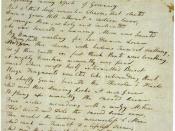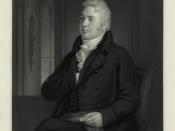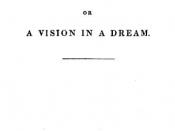Samuel Taylor Coleridge's visionary Kubla Khan (1797-8) arose out of a narcotic induced dream. According to the poet's preface, he had consumed an effective amount of laudanum, and while reading from Purchas Pilgrimage travel book of 1613, describing the Khan and his empire, he fell asleep - 'at least of the external senses' and dreamed that he had composed up to three hundred lines of poetry without conscious effort. However whilst documenting these lines he was interrupted by a 'person on business from Porlock' and found that afterwards he could only recollect 'eight or ten scattered lines and images'. Therefore this 'vision in a dream' remains a riddling fragment that activates the imagination of the reader whilst challenging him/her to acts of interpretation - as well as closure. The poem's striking exotic imagery and symbols, in addition to it's elements of history, folklore, nature, mythology and Gothic sublimity (all popular sources in the eighteenth century), elevate it as one of the most famous and puzzling poems of the Romantic period.
Moreover, it's unity of prophecies, myths and sacred texts, give it an imploded epic like quality. In this essay I will attempt to compose a commentary on Kubla Khan, breaking it down into four typographical units, examining the poem's content and form, as well as referring to it's metre and rhythm. In addition I would like this chance to point out that as Coleridge spoke in a Devonshire accent - the 'a' assonances in Xanadu and Khan are probably full rhymes with 'ran' and 'man'.
In the first unit of the poem Kubla (presumably the ancient leader and grandson of Genghis, merited for introducing Buddhism to his warlike culture) orders a grand dome of physical and mental enjoyment to be constructed, situated near to the sacred river Alph which...


